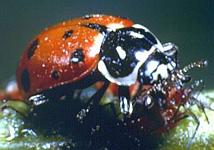[ad_1]
For years, well-meaning gardeners routinely maimed, swatted, sprayed, and squished every bug they could get their hands on. However, careful observation of nature and the move to organic practices have shown that encouraging beneficial insects is one way to give Mother Nature a hand.
Lets look at three common beneficials, and how to attract them to your garden:
Beetles
You undoubtedly know these large, fast moving, shiny metallic-blue-black beetles! They snooze underneath pieces of rotten logs and stones and are nocturnal, dining ravenously after dark upon cutworms, root maggots, and slug eggs, miscellaneous larvae and pupae of undesirables, flea beetles, and leaf hoppers.
To attract more beetles, imitate nature. Along a shady edge, away from foot traffic, dig a trench three to six inches deep, and a foot wide. Plant mint, or lemon balm, or even red or white clover, along the inside edges. Drop shovels of peat moss, leaf mulch, coniferous needles, whatever organic material you have, along the slopes and then place a couple of big, flat rocks in the ditch. The beetles will hide under the rocks in the daytime.
Syrphid Flies
Aka “hover flies” are important pollinators, and their larvae prey on many ‘bad’ bugs, but aphids are their favourite. Once hatched, the larvae decimate aphid families in a hurry. The 1/2 inch creature is often mistaken for a “bad” worm or slug, so if you come across a legless, see-through greenish-beige creature, slightly pointy at one end, do not kill him, but wish him ‘bon appetit’!
![]()
To attract syrphids, choose plants of the umbelliferae family: fennel, dill, caraway, parsley, coriander, yarrow, or allow carrots to winter over. All produce beautifully symmetrical seed-heads called umbels, attracting a host of beneficials. According to a recent Oregon State University study, buckwheat is also extremely attractive to syrphids. They also like cornflowers (bachelor buttons), marigolds, chamomile, coreopsis, and feverfew.
Lady Beetles
Also known as “ladybugs”, feed heavily on aphids. Become familiar with the ladybug in the larval stage. It looks a bit like an elongated grey-black dragon with many little legs, and orange to red markings.

All stages of ladybugs from larvae to adult feed on aphids. Ladybugs are attracted to cosmos, especially white, and to goldenrod, caraway, fennel, yarrow and other umbelliferae. All are easily grown from seed. Lady beetles also like to lay their eggs amongst the long grass, so try to leave a strip un-mowed if you can.
In general, beneficial insects are attracted to plants from families including compositae (daisy family); the mint family (all kinds of mints, lemon balm, and more); umbelliferae (carrot family, parsley, fennel); and the brassica family, a huge family which includes cabbages, cauliflower, oriental greens, arugula, radish and more. These produce flowers containing the type of nectar which beneficial insects use as fuel for flight and movement.
It’s also polite to offer your insect visitors a drink, in this case water, to wash the aphids down. This can be achieved simply: placing a plastic tray or any kind of pan in your garden and fill it with water. Put rocks in the water for them to stand on.
© Sharon Hanna is a Horticultural Writer for Terra Viva Organics
[ad_2]
Source link










